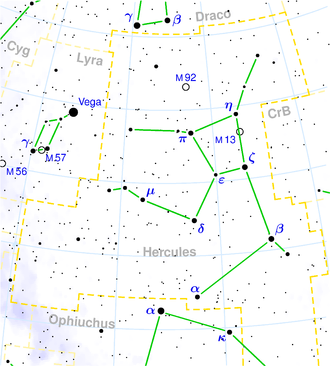IC 1277
| Galaxy IC 1277 |
|
|---|---|
|
|
|
| AladinLite | |
| Constellation | Hercules |
|
Position equinox : J2000.0 , epoch : J2000.0 |
|
| Right ascension | 18 h 10 m 27.29 s |
| declination | + 31 ° 00 ′ 11.4 ″ |
| Appearance | |
| Morphological type | Scd: |
| Brightness (visual) | 14.0 mag |
| Brightness (B-band) | 14.7 mag |
| Angular expansion | 1.20 'x 0.9' |
| Position angle | 25 ° |
| Surface brightness | 13.9 mag / arcmin² |
| Physical data | |
| Redshift | 0.023630 ± 0.000153 |
| Radial velocity | 7084 ± 46 km / s |
|
Stroke distance v rad / H 0 |
(325 ± 23) · 10 6 ly (99.6 ± 7.0) Mpc |
| history | |
| discovery | Guillaume Bigourdan |
| Discovery date | August 31, 1888 |
| Catalog names | |
| IC 1277 • UGC 11135 • PGC 61491 • CGCG 172-008 • MCG + 05-43-005 • IRAS F18085 + 3059 • 2MASX J18102728 + 3100112 • GALEX ASC J181027.37 + 310011.4 • WISEA J181027.29 + 310011.7 • NVSS J181027 + 310013 • KPG 530A | |
IC 1277 is a spiral galaxy of the Hubble type Sc with an active galaxy core in the constellation Hercules in the northern sky . It is an estimated 325 million light years from the Milky Way and about 115,000 light years in diameter. Together with NGC 6575 , it forms the isolated and gravitationally bound galaxy pair KPG 530 .
The supernovae SN 2006gz ( Type Ia ) and SN 2011ap (Type IIn) were observed here.
The object was discovered on August 31, 1888 by Guillaume Bigourdan .
Web links
- SIMBAD Astronomical Database
- Aladin Lite: IC 1277
